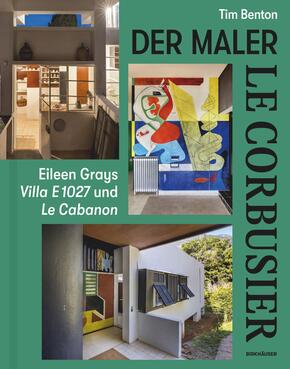Le Corbusier - Der Maler - Eileen Grays Villa E 1027 und Le Cabanon
| Verlag | Birkhäuser Berlin |
| Auflage | 2023 |
| Seiten | 136 |
| Format | 22,5 x 1,5 x 28,5 cm |
| Gewicht | 796 g |
| ISBN-10 | 3035626545 |
| ISBN-13 | 9783035626544 |
| Bestell-Nr | 03562654A |
E.1027 war das Haus, das die irische Architektin und Designerin Eileen Gray für sich und ihren jungen Geliebten, den rumänischen Architekten Jean Badovici, 1929 plante und erbaute. Sie entwickelte auch das Mobiliar für das Sommerhaus - der Beistelltisch E.1027 ist heute ein Designklassiker. Die Villa gilt mit ihrer Eleganz und den nautischen Bezügen als Kleinod der Moderne. Auf Einladung Badovicis schuf Freund und Nachbar Le Corbusier dort 1945 acht großformatige Wandgemälde - gegen den Willen der Hausherrin, die allerdings zu dem Zeitpunkt das Haus bereits für immer verlassen hatte. Die Publikation stellt die Gemälde vor und erzählt die ungewöhnliche Geschichte. Das Haus in Cap Martin an der Côte d'Azur ist seit aufwendigen Sanierungsmaßnahmen seit 2021 wieder für die Öffentlichkeit zugänglich.
Weiterhin geht das Buch auf die Malerei von Le Corbusier als Ganzes ein und zeigt seine Arbeiten in seinem eigenen Sommerhaus "Cabanon", ebenfalls in Cap Martin.
Die fasziniere nden Fotografien von Manuel Bougot fangen die besondere Atmosphäre der Villa ein Die weniger bekannte Malerei Le Corbusiers war prägend für seine lebenslange Beschäftigung mit der Polychromie Nach der aufwendigen Sanierung bis 2021 ist die Villa E1027, ebenso wie das Cabanon, wieder zugänglich
In 1929, Eileen Gray designed Villa E 1027 for herself and her youthful partner Jean Badovici, but only lived there for three years. Today, the elegant house in Roquebrune-Cap-Martin in southern France is an icon of modernism. In 1937, Le Corbusier discovered the place and the "Maison en Bord de Mer". Inspired by the genius of the place and the light on the Côte d'Azur, he created a total of five large-format wall paintings there from 1938 onwards, some of which complement the building congenially, while others set counterpoints. In 1952, he built his Cabanon nearby and decorated it with murals as well. The book by the well-known architectural historian Tim Benton documents Le Corbusier's artwork at this special place and places it in his overall oeuvre.
The fascinating photographs by Manuel Bougot capture the special atmosphere of the villa Le Corbusier's painting is lesser known but was formative for his lifelong preoccupation with polychromy After extensive renovatio n work until 2021, E 1027, as well as the Cabanon, is open to the public again




















